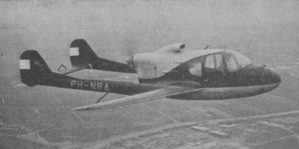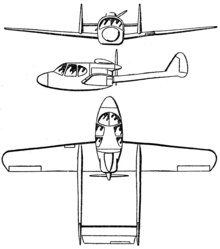Fokker F.25
The Fokker F.25 Promotor, first flown in 1946, was a single-engined, twin-boomed, four-passenger monoplane with a pusher engine mounted at the rear of a central nacelle. It was of wooden construction and has fitted with a retractable nosewheel undercarriage. One feature of the design was that instead of a 2 + 2 seating, the pilot sat in front to the left, and all three passengers were on a bench seat to the rear of him. Alternatively, when being used as an air ambulance aircraft, it could carry a patient on a stretcher, which was loaded through a hatch in the aircraft's nose.[1] The F.25 was evocative of the pre-war G.I design.[2] The F.25 was based upon the design of the Difoga 421 aircraft, home-built and -designed during World War II by Frits Diepen, a Ford garage owner from Tilburg, the Netherlands. His intention was to create an easy to fly personal aircraft. Due to the war an aircraft engine was not available and instead it used a Ford V-8.
| F.25 Promotor | |
|---|---|
 | |
| Fokker F25 over Schiphol | |
| Role | Civil utility aircraft |
| Manufacturer | Fokker |
| First flight | 1946 |
| Number built | 20 |
Although 20 F.25 aircraft were constructed, sales were disappointing as it could not compete in cost with thousands of surplus aircraft on the market following the war.
Specifications (Fokker F.25 with O-435-A engine)

Data from [3], Promotor In The Air[4]
General characteristics
- Length: 8.5 m (27 ft 11 in)
- Wingspan: 12 m (39 ft 4 in)
- Height: 2.4 m (7 ft 10 in)
- Wing area: 17.5 m2 (188 sq ft)
- Empty weight: 920 kg (2,028 lb)
- Gross weight: 1,350 kg (2,976 lb)
- Fuel capacity: 200 l (53 US gal; 44 imp gal)
- Powerplant: 1 × Lycoming O-435-A 6-cylinder air-cooled horizontally-opposed piston engine, 140 kW (190 hp) at 2,550 rpm for take-off
- 100 kW (140 hp) at 2,300 rpm at 1,000 m (3,300 ft)
- Propellers: 2-bladed two position or constant-speed pusher propeller
Performance
- Maximum speed: 217 km/h (135 mph, 117 kn) at sea level
- Cruise speed: 195 km/h (121 mph, 105 kn) at 1,000 m (3,300 ft)
- Landing speed: 90 km/h (56 mph; 49 kn)
- Range: 515 km (320 mi, 278 nmi) with 87 kg (192 lb) fuel
- 850 km (530 mi; 460 nmi) with maximum fuel
- Service ceiling: 3,600 m (11,800 ft)
- Absolute ceiling: 4,400 m (14,400 ft)
- Rate of climb: 2.7 m/s (530 ft/min)
- Time to altitude:
- 1,000 m (3,300 ft) in 7 minutes 12 seconds
- 2,000 m (6,600 ft) in 16 minutes 6 seconds
- 3,000 m (9,800 ft) in 30 minutes
- Wing loading: 77 kg/m2 (16 lb/sq ft)
- Power/mass: 0.0637 hp/lb (0.1047 kW/kg)
- Take-off run: 230 m (750 ft) in a 5 km/h (3.1 mph; 2.7 kn) wind
- Landing run: 150 m (490 ft)
- Specific fuel consumption: 0.088 kg/kW/ks (0.52 lb/hp/h) at cruising speed
References
- Smith Flight 5 August 1948, pp. 143–144.
- Flight 3 October 1946, p. 359.
- Bridgman, Leonard, ed. (1947). Jane's all the World's Aircraft 1947. London: Sampson Low, Marston & Co. pp. 153c–154c.
- Smith Flight 5 August 1948, p. 145.
Further reading
- "Fokker Redivivus". Flight. No. 3 October 1946. p. 359.
- Smith, Maurice A. "Promotor in The Air". Flight. No. 5 August 1948. pp. 143–145.
- Taylor, Michael J. H. (1989). Jane's Encyclopedia of Aviation. London: Studio Editions. p. 407.
- World Aircraft Information Files. London: Bright Star Publishing. pp. File 894 Sheet 38.